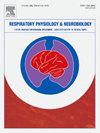Differential neuromotor control of the vertical and longitudinal genioglossus muscle fibers: An overlooked tongue retractor
IF 1.6
4区 医学
Q3 PHYSIOLOGY
引用次数: 0
Abstract
Introduction
The genioglossus (GG) is known to be the main tongue protrusor, and therefore plays a major role in breathing. However, due to the fan shape of the GG fibers, it could be assumed that contraction of the anterior fibers of the GG do not cause tongue protrusion. In this study, we examined the effect of contraction of the anterior-vertical fibers of the GG (GGV) on the tongue and their EMG activity during wakefulness and sleep. The findings were compared to those of the longitudinal fibers (GGL), which, based on their orientation, are responsible for tongue protrusion.
Methods
Fine-wire electrode pairs were placed into the GGV and GGL in 11 patients with untreated OSA. Movement of the tongue during electrical stimulation at each site was videoed. The same electrodes were used to record EMG from both sites during respiratory stimulation by inspiratory loading and CO2 rebreathing during wakefulness. During sleep, repetitive flow limitation events were induced with low-level CPAP to augment GG activity.
Results
In all participants, electrical stimulation of GGL and GGV protruded and retracted the tongue, respectively. Respiratory stimulation increased GG activity, but GGV reached only 39 % and 23 % of peak GGL activity during high resistive loading and PCO2 of 65 mmHg, respectively. Flow limitation during sleep increased GGL to levels that were considerably higher than awake baseline, but GGV activity remained tonic or with minimal phasic activity, reaching on average 15 % of GGL peak activity.
Conclusions
Our electrical stimulation findings indicate that GGV is a tongue retractor and depressor. Tongue stimulation for OSA should avoid this area. The EMG results demonstrate that the anterior part of the GG is controlled very differently from the longitudinal protrusive fibers. The GGV responses are similar to those previously found in tongue retractors and peri-pharyngeal muscles other than the GG, in which diminished activation during sleep is likely to be involved in the failure of increasing GGL activity to alleviate flow limitation.
纵向和纵向舌根肌纤维的不同神经运动控制:被忽视的缩舌器。
简介众所周知,舌根舌骨(GG)是主要的舌前伸肌,因此在呼吸中发挥着重要作用。然而,由于舌根舌肌纤维呈扇形,可以认为舌根舌肌前纤维的收缩不会导致舌前突。在这项研究中,我们研究了 GG 前垂直纤维(GGV)的收缩对舌头的影响,以及它们在清醒和睡眠时的肌电图活动。研究结果与纵向纤维(GGL)的研究结果进行了比较:方法:在 11 名未经治疗的 OSA 患者的 GGV 和 GGL 上放置细线电极对。对每个部位进行电刺激时舌头的运动情况进行录像。在清醒时通过吸气负荷和二氧化碳回吸进行呼吸刺激时,使用相同的电极记录这两个部位的肌电图。睡眠时,用低水平 CPAP 诱导重复性血流受限事件,以增强 GG 活动:结果:在所有参与者中,对 GGL 和 GGV 的电刺激分别会使舌头伸出和缩回。呼吸刺激增加了 GG 活动,但在高阻力负荷和 PCO2 为 65mmHg 时,GGV 只分别达到 GGL 活动峰值的 39% 和 23%。睡眠期间的流量限制使 GGL 增加到比清醒基线高得多的水平,但 GGV 活动仍保持强直或阶段性活动极少,平均达到 GGL 峰值活动的 15%:结论:我们的电刺激研究结果表明,GGV 具有缩舌和压舌作用。结论:我们的电刺激研究结果表明,GGV 是舌头的牵引器和抑制器,对 OSA 的舌头刺激应避开这一区域。肌电图结果表明,GG 的前部受到的控制与纵向突出纤维截然不同。GGV 的反应与之前在除 GG 以外的缩舌肌和咽周肌肉中发现的反应类似,其中睡眠期间激活的减少很可能与 GGL 活动的增加未能缓解血流限制有关。
本文章由计算机程序翻译,如有差异,请以英文原文为准。
求助全文
约1分钟内获得全文
求助全文
来源期刊
CiteScore
4.80
自引率
8.70%
发文量
104
审稿时长
54 days
期刊介绍:
Respiratory Physiology & Neurobiology (RESPNB) publishes original articles and invited reviews concerning physiology and pathophysiology of respiration in its broadest sense.
Although a special focus is on topics in neurobiology, high quality papers in respiratory molecular and cellular biology are also welcome, as are high-quality papers in traditional areas, such as:
-Mechanics of breathing-
Gas exchange and acid-base balance-
Respiration at rest and exercise-
Respiration in unusual conditions, like high or low pressure or changes of temperature, low ambient oxygen-
Embryonic and adult respiration-
Comparative respiratory physiology.
Papers on clinical aspects, original methods, as well as theoretical papers are also considered as long as they foster the understanding of respiratory physiology and pathophysiology.

 求助内容:
求助内容: 应助结果提醒方式:
应助结果提醒方式:


